T-80
The T-80 is a third-generation main battle tank (MBT) [11] designed and manufactured in the Soviet Union. When it entered service in 1976, it was the second MBT in the world to be equipped with a gas turbine engine after the Swedish Strv 103 and the first to use it as a primary propulsion engine. The T-80U was last produced in a factory in Omsk, Russia, while the T-80UD and further-developed T-84 continue to be produced in Ukraine. The T-80 and its variants are in service in Belarus, Cyprus, Egypt, Kazakhstan,[12] Pakistan, Russia, South Korea, and Ukraine. The chief designer of the T-80 was the Soviet engineer Nikolay Popov.[13]
| T-80 | |
|---|---|
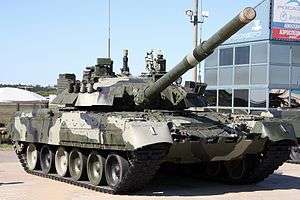 A T-80U tank at the Engineering Technologies 2010 international forum. | |
| Type | Main battle tank |
| Place of origin | Soviet Union |
| Service history | |
| In service | 1976–present |
| Used by | See Operators |
| Wars | First Chechen War Second Chechen War War in Donbass [1] |
| Production history | |
| Designer | Nikolay Popov, LKZ (T-80),[2] KMDB (T-80UD) |
| Designed | 1967–1975 |
| Manufacturer | LKZ and Omsk Transmash, Russia Malyshev Factory, Ukraine[3] |
| Unit cost | USD $3 million[4] |
| Produced | 1975– [5] |
| No. built | 5,575 (as of 2015)[3] |
| Variants | engineering & recovery, mobile bridge, mine-plough with KMT-6 plough-type system and KMT-7 roller-type system. |
| Specifications (T-80B / T-80U) | |
| Mass | 42.5 tonnes T-80B, 46 tonnes T-80U[6] |
| Length | 9.9 m (32 ft 6 in) T-80B, 9.654 m (31 ft 8.1 in) T-80U (gun forward) 7.4 m (24 ft 3 in) T-80B, 7 m (23 ft 0 in) T-80U, (hull)[6] |
| Width | 3.4 m (11 ft 2 in) T-80B 3.603 m (11 ft 9.9 in) T-80U[6] |
| Height | 2.202 m (7 ft 2.7 in) T-80B, T-80U[6] |
| Crew | 3[6] |
| Armour | |
Main armament | 125 mm 2A46-2 smoothbore gun,[9] 36 rounds T-80B, 2A46M-1 with 45 rounds T-80U 9M112 Kobra ATGM, 4 missiles T-80B, 9M119 Refleks ATGM, 6 missiles T-80U[6] |
Secondary armament | 7.62 mm PKT coax MG, 12.7 mm NSVT or DShK or PKT antiaircraft MG |
| Engine | SG-1000 gas turbine T-80B, GTD-1250 turbine T-80U, or one of 3 diesel T-80UD[10] 1,000 hp T-80B, 1,250 hp T-80U[6] |
| Power/weight | 23.5 hp (17.6 kW) / tonne T-80B 27.2 hp (20.3 kW) / tonne T-80U |
| Transmission | manual, 5 forward gears, 1 reverse T-80B, 4 forward, 1 reverse T-80U[6] |
| Suspension | torsion bar[6] |
| Ground clearance | 0.38 m (1.2 ft) T-80B, 0.446 m (1.46 ft) T-80U[6] |
| Fuel capacity | 1,100 litres (240 imp gal) (internal) 740 litres (160 imp gal) (external) |
Operational range | 335 km (208 mi) (road, without external tanks) 415 km (258 mi) (road, with external tanks)[6] |
| Maximum speed | 70 km/h (43 mph) (road) 48 km/h (30 mph) (cross country)[10] |
Development history
The project to build the first Soviet turbine powered tank began in 1949. Its designer was A. Ch. Starostienko, who worked at the Leningrad Kirov Plant (LKZ). The tank was never built because available turbine engines were of very poor quality. In 1955, two prototype 1,000 hp (746 kW) turbine engines were built at the same plant under the guidance of G. A. Ogloblin. Two years later a team led by Josef Kotin (best known for constructing the IS tank family, the Kliment Voroshilov tank among other tanks) constructed two prototypes of the Ob'yekt 278 tank. Both were hybrids of the IS-7 and the T-10 heavy tanks, powered by the GTD-1 turbine engine, weighing 53.5 tonnes and armed with an M65 130 mm tank gun. The turbine engine allowed the tank to reach a maximum speed of 57.3 km/h (35.6 mph), however with only 1,950 liters of fuel on board, their range was limited to only 300 km (190 mi). The two tanks were considered experimental vehicles and work on them eventually ceased. In 1963, the Morozov Design Bureau designed the T-64 and T-64T tanks. They used GTD-3TL turbine engines which generated 700 hp (522 kW). The tank was tested until 1965. At the same time, at Uralvagonzavod, a design team under the guidance of L. N. Kartsev created the Ob'yekt 167T tank. It used the GTD-3T turbine engine which supplied 801 hp (597 kW).[14]
In 1966, the Kirov factory built the experimental Ob'yekt 288 “rocket tank,” powered by two aerial GTD-350 turbine engines with a combined power of 691 hp (515 kW). Trials indicated that twin propulsion was no better than the turbine engine which had been in development since 1968 at KB-3 of the Kirov Plant (LKZ) and at WNII Transmash. The tank from LKZ equipped with this turbine engine was designed by Nikolay Popov. It was constructed in 1969 and designated Ob'yekt 219 SP1. It was renamed the T-64T, and was powered by a GTD-1000T multi-fuel gas turbine engine producing up to 1,000 hp (746 kW). During the trials it became clear that the increased weight and dynamic characteristics required a complete redesign of the vehicle's caterpillar track system. The second prototype, designated Ob'yekt 219 SP2, received bigger drive sprockets and return rollers. The number of wheels was increased from five to six. The construction of the turret was altered to use the same compartment, 125 mm 2A46 tank gun, auto loader and placement of ammunition as the T-64A. Some additional equipment was borrowed from the T-64A. The LKZ plant built a series of prototypes based on Ob'yekt 219 SP2. After seven years of upgrades, the tank became the T-80.[15]
Description
The T-80 is similar in layout to the T-64; the driver's compartment is on the centre line at the front, the two-man turret is in the centre with the gunner on the left and the commander on the right, and the engine is rear mounted.[16] Overall, its shape is also very similar to the T-64. The original T-80 design uses a 1,000 horsepower gas turbine instead of a 750-horsepower diesel engine, although some later variants of the T-80 reverted to diesel engine usage. The gearbox is different, with five forward and one reverse gear, instead of seven forward and one reverse. Suspension reverts from pneumatic to torsion bar, with six forged steel-aluminium rubber-tyred road wheels on each side, with the tracks driven by rear sprockets.[16] The glacis is of laminate armour and the turret is armoured steel. The turret houses the same 125 mm 2A46 smoothbore gun as the T-72, which can fire anti-tank guided missiles as well as regular ordnance.[16] The tracks are slightly wider and longer than on the T-64 giving lower ground pressure.[16]
The main gun is fed by the Korzina automatic loader. This holds up to 28 rounds of two-part ammunition in a carousel located under the turret floor.[17] Additional ammunition is stored within the turret. The ammunition comprises the projectile (APFSDS, HEAT or HE-Frag) plus the propellant charge, or the two-part missile.[17] The autoloader is an effective, reliable, combat tested system that has been in use since the mid-1960s. The propellant charge is held inside a semi-combustible cartridge case made of a highly flammable material – this is consumed in the breech during firing, except for a small metal baseplate.[17]
A disadvantage highlighted during combat in Chechnya was the vulnerability of the T-80BV to catastrophic explosion.[17] The reason given by US and Russian experts is the vulnerability of stored semi-combustible propellant charges and missiles when contacted by the molten metal jet from the penetration of a HEAT warhead, causing the entire ammunition load to explode.[17] This vulnerability may be addressed in later models. When Western tank designs changed from non-combustible propellant cartridges to semi-combustible, they tended to separate ammunition stowage from the crew compartment with armoured blast doors, and provided 'blow-out' panels to redirect the force and fire of exploding ammunition away from the crew compartment.[17]
The autoloader takes between 7.1 and 19.5 seconds to load the main weapon (28[18] rounds), depending on the initial position of autoloader carousel.
The T-80's armour is composite on the turret and hull, while rubber flaps and sideskirts protect the sides and lower hull. The later T-80 models use explosive reactive armour and stronger armour, like the T-80U and T-80UM1. Other protection systems include the Shtora-1 and Arena APS, as well as the discontinued Drozd APS.
The latest T-80 variant in service, the T-84 Oplot, has an entirely new turret with an armoured ammunition compartment to help prevent accidental detonation.
Production history
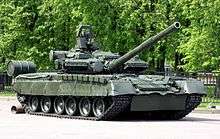
Initially, the T-80 was confused with the Soviet T-72 by some Western analysts. They are the products of different design bureaus; the T-80 is from the SKB-2 design bureau of the Kirov Factory (LKZ) in Leningrad while the T-72 is from the Uralvagonzavod factory in Nizhny Tagil. They are similar in superficial appearance, but the T-80 is based on the earlier T-64, while incorporating features from the T-72, which was a complementary design.[19] The T-64 in turn was an earlier high-technology main battle tank, designed by the Morozov Design Bureau (KMDB) to replace the T-54, T-55 and T-62 MBTs, used before in the Soviet Union.
From a long distance, the T-64, T-72 and T-80 look alike even though the T-80 is 90 cm longer than the T-64. Despite the similarities, the T-80 and T-72 are mechanically very different. The T-72 is mechanically simpler, easier to manufacture, and easier to service in the field. As such, the T-72 was intended to be a tank mass-produced to equip the bulk of the Soviet motor rifle units, and for sale to export partners and Eastern-bloc satellite states.
The T-80 design improved in several points upon the earlier T-64 design, introducing a gas turbine engine in the original model (which was denied for many years by Western analysts[12]), and incorporating suspension components of the T-72. This gave the tank a high power-to-weight ratio and made it easily the most mobile tank in service, albeit with acute range problems, as the turbine consumed fuel rapidly, even at engine idle. (Morozov's subsequent parallel development of the T-80UD replaced the gas turbine with a commercial turbo-diesel, to decrease fuel consumption and maintenance.) In comparison to its anticipated opponent, the M1 has a larger, 1,500 hp (1,120 kW), gas turbine, but weighs 61 tons compared to the T-80s 42.6 tons, so it has a worse hp/t ratio of 24.5 compared to 27.1 and is less maneuverable than the T-80 (with GT). The T-80 can fire the same 9K112 Kobra (AT-8 Songster) anti-tank guided missile through the main gun as the T-64.
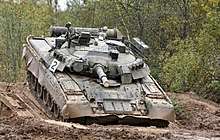
The T-80U main battle tank (1985, "U" for uluchsheniye, meaning "improvement") was designed by SKB-2 in Leningrad (hull) and the Morozov Bureau (turret and armament). It is a further development of the T-80A and is powered by the 1,250 hp (919 kW) GTD-1250 gas turbine. It is a step ahead of the GTD-1000T and GTD-1000TF engines that were installed on the previous tanks of the T-80 line. This gas turbine can use jet fuels as well as diesel and low-octane gasoline and has good dynamic stability, service life, and reliability. The GTD-1250 has a built-in automatic system of dust deposits removal. It retains the T-80s high fuel consumption, which the Russian army found unacceptable during the Chechen conflicts. It is equipped with the 2A46 fire control system and a new turret. The T-80U is protected by a second generation of explosive reactive armour called Kontakt-5, which can severely dissipate the penetrative capabilities of an APFSDS round, such as the M829A1 "Silver Bullet".[20]


The Kontakt-5 is integrated into the design of the turret, hull, and Brod-M deep wading equipment. Like all of the previous T-80 models, the T-80U has full length rubber side skirts protecting the sides with those above the first three road wheels being armoured and are provided with lifting handles. It can fire the 9M119 Refleks (AT-11 Sniper) guided missile and the long-rod penetrator (HVAPFSDS) 3BM46. The remotely-controlled commander's machine gun was replaced by a more flexible pintle-mounted one. A special camouflage paint distorts the tank's appearance in the visible and IR wavebands. The T-80U's 1A46 fire control system includes a laser range finder, a ballistics computer, and a more advanced 1G46 gunner's main sights, as well as thermal imaging sights, which greatly increases the T-80Us firepower over previous models. These new systems, together with the 125 mm D-81TM "Rapira-3" smooth bore gun, ensure that the T-80U can accurately hit and destroy targets at a range of up to 5 kilometers (ATGMs and HV/APFSDS). An experienced crew at the international exhibition was able to successfully strike 52 targets without a miss at a distance of 5 km using guided rockets.[21]
The T-80U(M) of the 1990s introduced the TO1-PO2 Agava gunner's thermal imaging sight and 9M119M Refleks-M guided missile, and later an improved 2A46M-4 version of the 125 mm gun and 1G46M gunner's sight was used.
Perhaps because of the turbine-powered tank's high fuel consumption, and the poor combat performance of older T-80BV tanks in the early days of the war in Chechnya,[22] the Russian Army decided to standardize on the Uralvagonzavod factory's T-90 tank (derived from the T-72BM, but incorporating some T-80 technology), and have had some success selling it to the Indian Army. All T-72s, T-80s, and even the T-90 are to be replaced starting in 2025 by a new Russian tank, the T-14 Armata. The Omsk Tank Plant in Siberia is facing a shortage of domestic orders, unlike the Ukrainians who embraced the T-80 design and have had success updating and selling the tank. The Russians have only sold a small number of T-80 tanks to South Korea, Cyprus and China, and have demonstrated versions intended for export, including the T-80UM1 with active protection systems, and the advanced T-80UM2 Black Eagle concept tank. Although T-80 production has stopped for the Russian Army, the Omsk plant still makes the tank for export.
Ukrainian T-80UD
In parallel with the T-80U and Russia in general, the Morozov Bureau in Ukraine developed a diesel-powered version, the T-80UD. It is powered by the 1,000-hp 6TD-6-cylinder opposed-piston [23] multi-fuel two-stroke turbo-piston diesel engine, ensuring high fuel efficiency and a long cruising range. The engine support systems make it possible to operate the tank at ambient temperatures of up to 55 °C and ford water obstacle 1.8 m in depth. The T-80UD shares most of the T-80U's improvements, but can be distinguished from it by a different engine deck and distinctive smoke-mortar array and turret stowage boxes. It retains the remotely-controlled commander's machine gun. About 500 T-80UD tanks were built in the Malyshev plant between 1987 and 1991. About 300 were still at the Ukrainian factory when the Soviet Union broke up, so the T-80UD tank was welcomed into Ukrainian military service, and therefore is more common in Ukrainian service than Russian. The T-84 and Ukraine's older T-80s are to be Ukraine's main battle tanks well into the 21st century.
A further development of the T-80UD became the Ukrainian T-84 MBT. It had a new welded turret, a 1,200-hp (895 kW) 6TD-2 engine, Kontakt-5 reactive armour, the Shtora active protection system, a thermal imaging sight, a muzzle referencing system, and an auxiliary power unit. In 1999 a new variant, T-84, appeared. This modification got many improvements, including deeper sideskirts, modified reactive armour, a small reference radar antenna near the gunner's hatch (used to track rounds and compensate for barrel wear), and a large armoured box for an auxiliary power unit at the rear of the right fender. Unlike Russia, Ukraine has had much better success selling T-80s (but not T-84s) to foreign customers. Cyprus bought a number of T-80Us and T-80UKs from Russia for its army. Pakistan, countering India's adoption of the Russian T-90, bought Ukrainian T-80UDs for its main armoured corps of the Pakistani Army. The T-84 Oplot (ten delivered in 2001) introduced turret-bustle ammunition storage, and to offer more sales to international market, the T-84-120 Yatagan has been offered for export, featuring a very large turret bustle and NATO-compatible 120 mm gun. In 2010, Bangladesh discussed a major purchase of T-84 Yatagans, however finally dropped it in favor of MBT-2000s. In 2011, Azerbaijan announced its intention to buy Ukrainian T-84 Oplots for its ground forces, but subsequently decided to purchase ninety-four Russian T-90s.
T-80 models

This section lists the main models of the T-80, built in the Soviet Union, Russia and Ukraine, with the dates they entered service.
Command tanks with additional radio equipment have K added to their designation for komandirskiy ("command"), for example, T-80BK is the command version of the T-80B. Versions with reactive armour have V added, for vzryvnoy ("explosive"), for example T-80BV. Less-expensive versions without missile capability have a figure 1 added, as T-80B1.
- T-80 (1976): Initial model, with 1,000-hp gas turbine engine, coincidence rangefinder, and no missile capability. This model does not have fittings for explosive reactive armour. The turret is from the T-64A, and thus retains the use of the old coincidence rangefinder. Characteristics of this type are the V shaped water deflector on the front glacis, coincidence rangefinder in front of the commander's cupola, and Luna searchlight mounted in the same position as a T-64. Around 250 were produced, as the tank's armour was essentially obsolete when introduced. Turret vs APFSDS – 380 mm, hull vs APFSDS – 500 mm (without reactive armour).[24] This was, in effect, a pre-production model. It reportedly was fitted with an early version of the Shtora APS.
- T-80B (1978): This model had a new turret, laser rangefinder, fire-control, and autoloader allowing the firing of 9M112-1 Kobra antitank guided missile (80% probability of destroying an armored target while stopped and on the move),[18] and improved composite armour. An improved, 1,100-hp, engine was added in 1980, a new gun in 1982, and fittings for reactive armour in 1985. Reactive armour added protection of 400 mm equivalent armour to defend against HEAT warheads. The longest sighting range for T-80B kinetic energy ammunition and for "cumulative" ammunition – 4,000 m, high-explosive fragmentation – 5,000 m (using the "side level" – 10,000 m). A night sight TPNZ-49 in active mode reached 1,300 and a passive – 850 m. "Reflex" guided missile complex with laser beam allowed it to launch missiles at any tank speed.[25]
- T-80BV (1985): T-80B with explosive reactive armour Kontakt-1
- T-80UM: Russian version, with new Buran thermal imaging sight in place of the Luna IR.[26]
- Object 219A: Early T-80U (Object 219AS) variant. It has the T-80U's turret, but not the Kontakt-5 ERA. Instead, it uses the old Kontakt-1/3 system; some 219As did not have ERA at all. Often misnamed T-80A.
- T-80U (1985): Further development with a better turret, Kontakt-5 explosive reactive armour, improved gunsight, and 9M119 Svir missile system. In 1990 a new, 1,250-hp, engine was installed. Overall protection with Kontakt-5 against APFSDS/HEAT is 780/1,320 mm RHAe.[8] 9K119M with antitank guided missile 9M119M installed since 1990. Some of the tanks in commander version (T-80UK) equipped with Shtora-1 APS, and thermal imaging night sight TO1-PO2T (detection range / target classification range = 6,400/4,600 meters at night). Basic thermal night sight of the T-80U is within the limits of 1,750/1,500 meters.[24]
- T-80UD Bereza (1987): Ukrainian diesel version with 1,000-hp 6TD engine and remote-controlled antiaircraft machine gun
- T-84 (1999): Further Ukrainian development of T-80UD with 1,200-hp diesel and new welded turret
- T-80BVD (2002): KMDB's upgrade standard for Ukrainian T-80BVs. Changes include the 6TD diesel engine, remote-controlled commander's machine gun, and better optics. None were produced.
- T-80UM2/Black Eagle (prototype: cancelled): Several Russian prototypes were shown at trade shows, with a longer chassis and extra pair of road wheels, and very a large turret with separate ammunition compartment.[26]
- T-80BVM (2017): Installed "Relikt" ERA, PNM Sosna-U gunner sight (as in the T-90, T-72B3), the improved 125mm gun 2A46M-4, the upgraded gas turbine engine and the upgrades of various other systems.[27][28][29] The Russian armed forces have received all the modernized T-80BVM tanks under the contact with the Rostec corporation, signed in 2017, Rostec said on 12 December 2019.[30]
Service history
Soviet Union
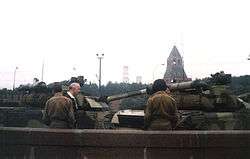
In 1985 there were 1,900 T-80 MBTs overall.[31] According to data publicized in Russia, 2,256 T-80 MBTs (up to the T-80BV model, as T-80Us were never deployed in Europe) were stationed in East Germany between 1986 and 1987. NATO realized that new Soviet tanks could reach the Atlantic within two weeks and because of that started to develop counter methods that could stop them. This led to a sudden increase in development of anti-tank weapons including attack helicopters. In 1991 when the Soviet Union was breaking up, the Soviet Army operated 4,839 T-80 MBTs in several different models.[32]
T-80 MBTs were never used in the way in which they were intended (large-scale conventional war in Europe). They were deployed during the political and economical changes in Russia in the 1990s. In August 1991 communists and allied military commanders tried to overthrow Mikhail Gorbachev and regain control over the unstable Soviet Union. T-80UD tanks of the Russian 4th Guards Kantemirovskaya Tank Division drove onto the streets of Moscow but the Soviet coup attempt failed when the tank crews refused to attack the audience or the parliament.[33][34]
Russia
While a number of T-80 MBTs were inherited by Ukraine, Belarus and Kazakhstan, Russia had possession of the majority of the tanks.
In 1995, the number of T-80 tanks increased to around 5,000 but was reduced in 1998 to 3,500.
The Russian Army had 3,044 T-80s and variants in active service and 1,456 in reserve as of 2008.[31][32][35] There are at least 460 T-80UD in service with 2nd Guards Tamanskaya Motor Rifle Division and 4th Guards Kantemirowsk Motor Rifle Division.[36] A T-80BV is on display in Kubinka Tank Museum and a T-80U is on display at an open-air museum in Saratov. The T-80Us have recently been seen at arms expos in Russia such as VTTV.
During the 1993 Russian constitutional crisis, Boris Yeltsin ordered the use of tanks against the Supreme Soviet and the Congress of People's Deputies opposing him. On 4 October 1993, six T-80UD MBTs from the 12th Guards Tank Regiment, 4th Guards Kantemirovskaya Tank Division took positions on a bridge opposite the Russian parliament building, and fired on it.
In July 1998, a T-80 commanded by Major Igor Belyaev was driven onto a square in front of the administration building of Novosmolensk and its gun aimed at the building in protest of several months of unpaid wages.[12]
The T-80's first (and only) use in combat was in 1994 in the First Chechen War, where they suffered heavy losses in urban combat. Due to design flaws and high operating costs, Russia has not used the tanks in later conflicts such as the 1999 Second Chechen War, 2008 Russo-Georgian War.[37]
First Chechen War
T-80B and T-80BV MBTs were never used in Afghanistan in the 1980s to maintain the tank's characteristics secret, but they were first used during the First Chechen War. This first real combat experience for T-80 MBTs was unsuccessful, as the tanks were used for capturing cities, a task for which they were not very well suited. The biggest tank losses were suffered during the ill-fated assault on the city of Grozny. During the two-days battle for the railway station, more than 450 Chechen rebels were killed.[38] During three months of combat, 84 T-80 tanks were used. The 133rd Tank Battalion used 53 T-80s and lost 12 of them. The 3rd Tank Battalion used 31 T-80s and lost 6 of them.[39] The forces selected to capture Grozny were not prepared for such an operation, while the city was defended by, among others, veterans of the Soviet–Afghan War. The T-80 tanks used in this operation either did not have reactive armour (T-80B) or they were not fitted with explosive inserts before the start of the operation (T-80BV), and the T-80 crews lacked sufficient training before the war.
Several tank-to-tank battles were recorded. During the fighting in late December 1994 - early January 1995, Russian T-80 tanks destroyed at least six rebel tanks. One T-80 was disabled by the hit of one 125-mm shell[40], the other one T-80 received 3 or 4 hits of tank shells but remained in service.[41][42] In August 1996, T-80 destroyed one rebel tank.[43]
The inexperienced crews had no knowledge of the layout of the city, while the tanks were attacked by RPG teams hidden in cellars and on top of high buildings. The anti-tank fire was directed at the least armoured points of the vehicles. Each destroyed tank received from three to six hits, and each tank was fired at by six or seven rocket-propelled grenades. A number of vehicles exploded when the autoloader, with vertically placed rounds, was hit: in theory it should have been protected by the road wheel, but, when the tanks got hit on their side armour, the ready-to-use ammunition exploded.[44] The T-80 performed so poorly that General-Lieutenant A. Galkin, the head of the Armor Directorate, convinced the Minister of Defence after the conflict to never again procure tanks with gas-turbine engines.[45] After that, T-80 MBTs were never again used to capture cities, and, instead, they supported infantry squads from a safe distance. Defenders of the T-80 point out that the T-72 performed just as badly in urban fighting in Grozny as the T-80 and that there were two mitigating factors: after the breakup of the Soviet Union, poor funding meant no training for new Russian tank crews, and the tank force entering the city had no infantry support, which is considered to be suicidal by many major military strategists of armored warfare.[36]
Exported T-80s
United Kingdom
In 1992, the United Kingdom bought a number of T-80U MBTs for defence research and development. They were not bought officially but through a specially created trading company, which was supposed to deliver them to Morocco. The price of five million USD offered for each tank ensured a lack of suspicion on the part of the Russians. Britain evaluated the tanks on their proving grounds and transferred one to the US where the Americans evaluated it on the Aberdeen Proving Ground. In January 1994, British Minister of State for Defence Procurement Jonathan Aitken confirmed in parliamentary debates that a Russian T-80U tank was imported for "defence research and development purposes".[46][47]
China
According to some sources, in late 1993 Russia signed a contract with China for the sale of 200 T-80U MBTs for evaluation. Only 50 were delivered.[48][49][50]
Pakistan
Ukrainian exports of the T-80UD have been moderately successful. In 1993 and 1995, Ukraine demonstrated the tank to Pakistan, which was looking for a new main battle tank. The tank was tested in Pakistan and in August 1996 Pakistan decided to buy 320 T-80UD tanks from Ukraine for $650 million in two variants: a standard Ob'yekt 478B and export Ob'yekt 478BE.[48][51][52][53] The tanks were all supposed to be delivered in 1997. After the first batch of 15 vehicles had been shipped in February 1997, Russia protested that it held the rights to the tank and that Ukraine couldn't export it.[48][51] Nearly 70% of T-80UD components were produced outside of Ukraine (mainly in Russia). Under the guise of keeping good relations with India, one of its most important military customers, Russia withheld 2A46-2 125 mm smoothbore guns, cast turrets and other technology, which forced Ukraine to make its tank industry independent.[53] It developed domestic components, including a welded turret, which was in use on the new T-84. Ukraine was able to ship 20 more T-80UD tanks to Pakistan between February and May 1997.[48][51] These 35 tanks were from Ukrainian Army stocks of 52 T-80UDs; they were built in the Malyshev plant several years before but were not delivered to their original destination. Their capabilities were below the standard agreed by both Ukraine and Pakistan.[51] The contract was completed by shipping another 285 Ukrainian T-80UD MBTs between 1997 and early 2002. These had the welded turret and other manufacturing features of the T-84.[48][51]
Cyprus
Cyprus is the first foreign country to officially obtain T-80 tanks. Russia sold 27 T-80U and 14 T-80UK for $174 million to Cyprus in 1996. The tanks arrived in two batches. The first shipment consisted of 27 T-80U MBTs arriving in 1996, while the second batch of 14 T-80UK MBTs arrived in 1997. This significantly improved the capabilities of Cypriot army armoured formations; their most potent tank up until that point was the AMX-30B2. New tanks gave the Cypriot National Guard the edge in a possible confrontation with the Turkish Army in Northern Cyprus.[48][54][55] In October 2009 Cyprus ordered an additional batch of 41 used T-80Us and T-80UKs from Russia for €115 million. Deliveries were completed in the first half of 2011.[56]
South Korea
South Korea was given 33 T-80U and 2 T-80UK tanks to pay Russian debts incurred during the days of the Soviet Union. The tanks came in three batches; the first consisted of six T-80Us in 1996, followed by 27 T-80Us in 1997, and finally two T-80UKs in 2005. Originally, eighty T-80Us were planned. As of 2016, these T-80Us are being retired due to cost and maintenance reasons.[48][54]
When South Korea first acquired the T-80 in the late 1990s, it was the most advanced tank on the Korean Peninsula, superior to the domestic K1 88-Tank in having a larger 125 mm gun to the K1's 105 mm. However, as time went on, the K1 was upgraded into the K1A1 and the more advanced K2 Black Panther entered service, while the T-80 changed little since its delivery due to the foreign nature of the design and lack of will to add domestic upgrades. While the South Korean tanks use domestically manufactured ammunition, T-80 shells as well as the majority of parts have to be imported, increasing maintenance costs as the cost of ordering replacement parts kept steadily rising. Although the turbine engine is lighter with better acceleration, it is more fuel consumptive and has reliability problems. The interior has been criticized as cramped and gunnery was underperforming from less advanced sights and slower reload speed.[57]
United States
The US government obtained one T-80U from the United Kingdom. It was evaluated on the Aberdeen Proving Ground.[46] In 2003, Ukraine transferred four T-80UD MBTs to the US.[58]
Failed export attempts
Apart from Cyprus and the People's Republic of China,[48] Russia has tried to export T-80 MBTs to Turkey and Greece, who were looking for new tanks. These two attempts have failed.[48] Sweden regarded the T-80 an alternative for its mechanized brigades in the early 1990s should the Leclerc be adopted for her armoured brigades, but since the new upgraded Leopard 2 (Strv 122) was chosen, Leopard 2A4s (Strv 121) equipped the mechanized brigades as to simplify logistics.
Operators
Under the Soviet Union, the T-80 was never exported, only after the collapse of the Soviet Union, when the T-80 was henceforth produced in Russia, was it exported.
Current operators



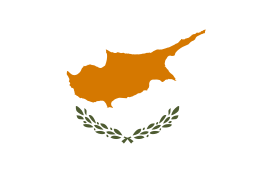

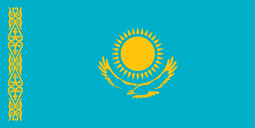




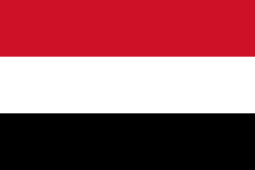
Former operators

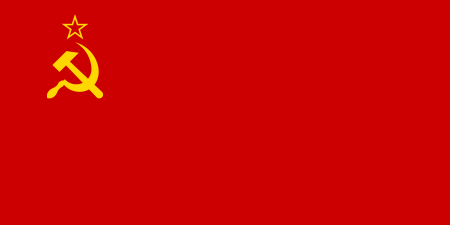
Failed bids




See also
Tanks of comparable role, performance and era
- Challenger 1: Approximate British equivalent
- Challenger 2: Approximate British equivalent
- Al-Khalid: Approximate Pakistani equivalent
- M1 Abrams: Approximate American equivalent
- AMX Leclerc: Approximate French equivalent
- Leopard 2: Approximate German equivalent
- C1 Ariete: Approximate Italian equivalent
- Type 96/Type 99 tank: Approximate Chinese equivalent
Notes
- Notes
- Citations
- OSCE "Latest from OSCE Special Monitoring Mission (SMM) to Ukraine based on information received as of 18:00 (Kyiv time), 22 January 2015 Archived 25 January 2015 at the Wayback Machine", January 22, 2014.
- Foss 2005, p.89.
- Foss 2005, p. 94.
- Dejong 1995
- "Archived copy". Archived from the original on 2012-05-23. Retrieved 2012-04-11.CS1 maint: archived copy as title (link)
- Foss 2005, p. 93.
- "Archived copy" (PDF). Archived (PDF) from the original on 2015-09-24. Retrieved 2014-11-12.CS1 maint: archived copy as title (link)
- Zaloga., Steven J. (17 February 2009). T-80 Standard Tank. Osprey Publishing. p. 24. ISBN 978-1-84603-244-8.Author Mentions that Russian sources claim Kontakt-5 and the new turret armor provided an unprecedented amount of protection for the T-80U, equivalent to 780mm against APFSDS and 1,320mm against HEAT in the turret front.
- Baryatinsky, p 23.
- Baryatinsky, p 95.
- http://www.tanks-encyclopedia.com/coldwar/USSR/T-80.php
- Kolekcja Czołgi Świata, Issue 8
- "Умер создатель "летающего танка"". Lenta. 2008-02-06. Archived from the original on 2008-02-29. Retrieved 2008-02-28.
- Kolekcja Czołgi Świata, Issue 8, pp 1,2
- Kolekcja Czołgi Świata, Issue 8, p 2
- Foss 2005, pp. 89–90.
- Warford 1995, pp 18–21
- "Archived copy". Archived from the original on 2014-12-13. Retrieved 2014-12-06.CS1 maint: archived copy as title (link)
- Sewell 1998, pp 28,29.
- "Modern Explosive Reactive Armours". Fofanov.armor.kiev.ua. Archived from the original on 2013-09-27. Retrieved 2013-09-22.
- "ČŃĻŪŅĄĶČß ŅĄĶŹĄ Ņ-90". www.sinopa.ee. Archived from the original on 2015-09-24. Retrieved 2014-12-05.
- Zaloga 2000, p 3.
- http://trosol-defence.com/wp-content/uploads/2017/02/6TD-engines-presentation.pdf
- "Основной боевой танк Т-80". dokwar.ru. Archived from the original on 2014-12-06. Retrieved 2014-12-05.
- "Основной танк Т-80 - Вооружение России и других стран Мира". worldweapon.ru. Archived from the original on 2014-12-08. Retrieved 2014-12-05.
- "Fprado.com". www.fprado.com. Archived from the original on 2006-07-09. Retrieved 2006-06-26.
- "Танк Т-80 модернизируют "Реликтом" и "Сосной-У"". 14 July 2016. Archived from the original on 15 November 2016. Retrieved 14 November 2016.
- "Archived copy". Archived from the original on 2017-08-26. Retrieved 2017-08-26.CS1 maint: archived copy as title (link)
- "Archived copy". Archived from the original on 2018-12-22. Retrieved 2018-12-22.CS1 maint: archived copy as title (link)
- https://sputniknews.com/military/201912121077550731-contract-on-delivering-t-80bmv-tanks-to-russian-army-fulfilled---rostec/
- John Pike. "Russian Army Equipment". Archived from the original on 26 June 2012. Retrieved 15 November 2014.
- Kolekcja Czołgi Świata, Issue 8, p 10
- Kolekcja Czołgi Świata, Issue 8, p 11
- Zaloga 1992 (no page numbers). The official designation of the newly revealed T-80U/T-80UD was unclear at the time of publication, and Zaloga labels the photographs "T-80U", but the description and photographs are clearly of the diesel-powered T-80UD.
- "warfare.be". warfare.be.
- Kolekcja Czołgi Świata, Issue 8, pp 11,12
- The T-80 Is Russia’s Most Overrated Tank Archived 2016-09-07 at the Library of Congress Web Archives - Warisboring.com, 10 August 2015
- Новогодняя Карусель. Сергей Мирошник
- В. Белогруд (2008), Танки в боях за Грозный [Tanks in the battle of Grozny] (in Russian), Часть 2, pp. 48–50
- В. Белогруд. Танки в боях за Грозный. Часть 1. Фронтовая иллюстрация, № 9, 2007, стр. 21-25, 35-37
- «Новогодняя карусель» (Второе издание 09.12.2011)
- В. Белогруд. Танки в боях за Грозный. Часть 2. Фронтовая иллюстрация, № 1, 2008, стр.59
- В. Белогруд. Танки в боях за Грозный. Часть 1. Фронтовая иллюстрация, № 9, 2007, стр. 21-25, 35-37
- "Foreign Military Studies Office Publications – Russian-Manufactured Armored Vehicle Vulnerability in Urban Combat: The Chechnya Experience". Fas.org. Archived from the original on 2013-11-13. Retrieved 2013-09-22.
- Mikhail Zakharchuk, 'Uroki Chechenskogo krizisa' (Lessons of the Chechen crisis), Armeyskiy sbornik, April 1995, 46.
- Kolekcja Czołgi Świata, Issue 8, p 12
- Hansard Debates for 3 Feb 1994 Archived 10 September 2017 at the Wayback Machine UK House of Commons
- Kolekcja Czołgi Świata, Issue 8, p 13
- "JED The Military Equipment Directory". Archived from the original on December 14, 2007.
- John Pike. "Global Security T-80". Archived from the original on 7 October 2014. Retrieved 15 November 2014.
- "T-80UD" Archived 2008-08-01 at the Wayback Machine Global Security
- "T-80UD". www.deagel.com. Archived from the original on 2016-03-03. Retrieved 2008-08-20.
- [Nowa Technika Wojskowa issue 07/09]
- "T-80U". www.deagel.com. Archived from the original on 2008-08-20. Retrieved 2008-08-19.
- "SIPRI Arms Transfers Database". Archived from the original on 5 August 2009. Retrieved 15 November 2014.
- Archived March 17, 2012, at the Wayback Machine
- Why South Korea Hates (and Loves) Its Russian Tanks Archived 2018-04-16 at the Wayback Machine. The National Interest. 15 April 2018.
- United Nations Register of Conventional Arms Archived 2011-07-28 at the Wayback Machine
- John Pike. "Global Security.org: Belarus". Archived from the original on 16 February 2017. Retrieved 15 November 2014.
- "Procurement: July 15, 2002". Strategypage.com. Archived from the original on September 27, 2013. Retrieved September 22, 2013.
- "T-80U Main Battle Tank". http://www.military-today.com. Archived from the original on 2013-12-27. Retrieved 2014-04-27. External link in
|publisher=(help) - "Archived copy" (in Russian). Archived from the original on 2014-03-24. Retrieved 2014-04-27.CS1 maint: archived copy as title (link)
- 360, Jane's (2016). "Russia may upgrade and return T-80BV tanks to service". Archived from the original on 30 April 2017. Retrieved 21 May 2017.CS1 maint: numeric names: authors list (link)
- Independent, The (2016). "Russia 'preparing bring to up to 3,000 Soviet-era T-80 tanks back into service'". Archived from the original on 16 June 2017. Retrieved 21 May 2017.
- Star, Daily (2016). "Vladimir Putin just ordered 3,000 new tanks – SIX TIMES what Britain has in TOTAL". Archived from the original on 9 May 2017. Retrieved 21 May 2017.
- John Pike. "ROK Army Equipment- South Korea". Archived from the original on 9 October 2014. Retrieved 15 November 2014.
- "Archived copy". Archived from the original on 2016-10-18. Retrieved 2016-10-16.CS1 maint: archived copy as title (link)
- John Pike. "Global Security.org: Ukraine". Archived from the original on 7 July 2017. Retrieved 15 November 2014.
- Russian arms sales to Yemen grow Archived 2011-09-27 at the Wayback Machine
- "Конфликт в Йемене стал третьей войной для "летающего танка" Т-80БВ". 20 December 2017. Archived from the original on 28 December 2017. Retrieved 28 December 2017.
- "Republic of Bulgaria Military Statistics (As of November 14, 2013):". Unknown/. March 19, 2016. Archived from the original on March 3, 2016. Retrieved March 19, 2016.
- Zaloga 2009, p. 34.
References
- "T-80BW". Kolekcja Czołgi Świata (in Polish) (8). Poland: Oxford Educational. 2007. ISBN 978-83-7425-773-2.
- Baryatinskiy, Mikhail (2007). Main Battle Tank T-80. Hersham, UK: Ian Allan. ISBN 978-0-7110-3238-5.
- Dejong, Bruce (January 1995). "T-80U Main Battle Tank". Red Thrust Star. US Army. Archived from the original on 2008-02-04.
- Foss, Christopher (2005). Jane's Armour & Artillery, 2005–2006. Coulsdon: Jane's Information Group. ISBN 978-0-7106-2686-8.
- Grau, Lester W. (January 1997). "Russian-Manufactured Armored Vehicle Vulnerability in Urban Combat: The Chechnya Experience". Red Thrust Star. US Army. Archived from the original on 2009-07-09.
- Karpenko, A.V. (1996). Obozreniye Bronetankovoy Tekhniki (1905–1995 gg.) (in Russian). Nevskiy Bastion. OCLC 41208782.
- Sewell, Stephen "Cookie" (July–August 1998). "Why Three Tanks?" (PDF). Armor. Fort Knox, KY: US Army Armor Center. CVII (4). ISSN 0004-2420. PB-17-98-4. Archived from the original (PDF) on 2016-03-04. Retrieved 2016-02-07.
- Warford, James M. (1995). "Cold War Armor After Chechnya: An Assessment of the Russian T-80" (PDF). Armor. Fort Knox, KY: US Army Armor Center. ISSN 0004-2420.
- Zaloga, Steven (1992). T-64 and T-80. Hong Kong: Concord. ISBN 962-361-031-9.
- Zaloga, Steven; Markov, David (2000). Russia's T-80U Main Battle Tank. Hong Kong: Concord. ISBN 962-361-656-2.
- Zaloga, Steven (2009). T-80 Standard Tank. Great Britain: Osprey Publishing. ISBN 978-1-84603-244-8.CS1 maint: ref=harv (link)
External links
| Wikimedia Commons has media related to T-80 tanks. |